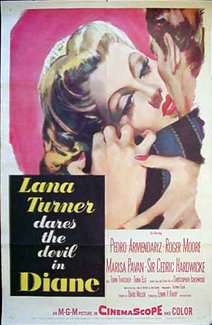Diane (1956 film)
| Diane | |
|---|---|
 Original film poster | |
| Directed by | David Miller |
| Written by | Christopher Isherwood John Erskine |
| Produced by | Edwin H. Knopf |
| Starring | Lana Turner Pedro Armendáriz Roger Moore Marisa Pavan Sir Cedric Hardwicke Torin Thatcher Taina Elg John Lupton Henry Daniell |
| Cinematography | Robert H. Planck |
| Edited by | John McSweeney Jr |
| Music by | Miklós Rózsa |
Production company | |
Release date |
|
Running time | 110 min |
| Country | United States |
| Language | English |
| Budget | $2,660,000[1] |
| Box office | $1,232,000[1] |
Diane is a 1956 American historical film drama about the life of Diane de Poitiers, produced by Metro-Goldwyn-Mayer, directed by David Miller, and produced by Edwin H. Knopf from a screenplay by Christopher Isherwood based on a story by John Erskine. The music score was composed by Miklós Rózsa, and Robert H. Planck was the cinematographer, who filmed in CinemaScope and Eastmancolor. The exceptionally lavish costumes were designed by Walter Plunkett.
The film stars Lana Turner, Pedro Armendáriz, Roger Moore, and Marisa Pavan, and features Sir Cedric Hardwicke, Torin Thatcher, Taina Elg, John Lupton, Henry Daniell, Melville Cooper and an early film appearance by Stuart Whitman. It was Turner's last film under her longtime MGM contract and thus marked another stage in the decline of the studio star system.
Plot
The action is set in 16th-century France.
Diane de Poitiers (Lana Turner) becomes the mistress of Prince Henri (Roger Moore), second in line to the throne. Their liaison continues through Henri's arranged marriage to the Italian Catherine de' Medici (Marisa Pavan).
Unknown to Catherine, her Medici relations arrange the death of the Dauphin and Henri's ascent to the throne as King Henry II. The antagonism of the two women, abetted by Medici scheming, eventually results in the death of Henri. Catherine, now ruling as regent for her three young sons, banishes Diane but spares her rival's life in a gesture of mutual respect.
Cast
- Lana Turner as Diane de Poitiers
- Pedro Armendáriz as King Francis I of France
- Roger Moore as Prince Henri (later King Henry II)
- Marisa Pavan as Catherine de' Medici
- Sir Cedric Hardwicke as Ruggieri
- Torin Thatcher as Count de Brèze
- Taina Elg as Alys
- John Lupton as Regnault
- Henry Daniell as Gondi
- Ronald Green as The Dauphin
- Sean McClory as Count Montgomery
- Geoffrey Toone as Duke of Savoy
- Michael Ansara as Count Ridolfi
- Melville Cooper as Court Physician
- Jamie Farr as count Ridolfi's squire
Production

The film was based on a fifty-page unpublished manuscript called "Diane de Poitiers" by John Erskine, who died in 1951. Film rights were bought in 1939 by producer Edwin H Knopf, story editor for Sam Goldwyn.[2] Knopf tried to get financing for the film but was unable.
In 1953 the project was reactivated. Knopf re-secured the film rights from Erskine's estate and took the project to Dore Schary, head of production at MGM, where Knopft had a deal. Schary agreed to finance. Greer Garson was originally mentioned as a possible lead.[3] Schary also announced he hoped to get Greta Garbo to come out of retirement to play the role.[4] It eventually went to Lana Turner.
Turner said Diane was an interesting woman "one who used her charm intelligently. Actually she was a forerunner of today's modern woman; she was Europe's first outdoor girl, a health fan and an advocate of the cold bath. She wasn't afraid to use her head, but was never caught with her brains showing."[5]
Reception
Christopher Isherwood deplored the treatment of his screenplay, attributing the problems to interventions by the leading lady.
Miklós Rózsa created an arrangement of his music called "Beauty and Grace," and his score has been issued on compact discs by Film Score Monthly.
Box Office
The film was an expensive failure at the box office - according to MGM records it made only $461,000 in the US and Canada and $771,000 elsewhere resulting in a loss of $2,660,000.[1]
DVD
Diane was released to DVD by Warner Home Video on May 28, 2013 via the Warner Archive DVD-on-demand service.
See also
References
- ^ a b c The Eddie Mannix Ledger, Los Angeles: Margaret Herrick Library, Center for Motion Picture Study.
- ^ Parsons, Louella O. (25 July 1939). "Close-Ups and Long-Shots Of the Motion Picture Scene". The Washington Post. p. 8.
- ^ Pryor, Thomas M. (16 Feb 1953). "KNOPF TO PRODUCE STORY BY ERSKINE: Unpublished 'Diane de Poitiers' Will Be Filmed Independently -- Garson Eyed for Lead". New York Times. p. 16.
- ^ Pryor, Thomas (1 Feb 1954). "METRO STRESSING CINEMASCOPE USE: Five of Eight Films to Be Done in April and May Set for Wide Screen". New York Times. p. 19.
- ^ Hopper, Hedda (18 Dec 1955). "Lana Shies at Glamour, Longs for High Comedy". Los Angeles Times. p. D1.
External links
- Diane at IMDb
- Diane at Rotten Tomatoes
- Diane at AllMovie
- Diane at the TCM Movie Database
- Diane at the AFI Catalog of Feature Films
